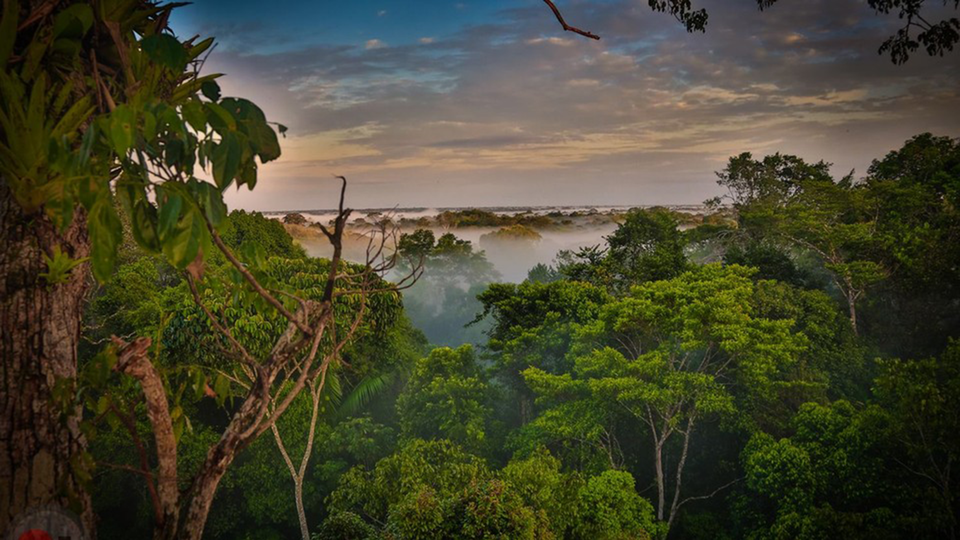An expert in ecosystem science and sustainability, Dr. Foley is steering the Academy through an exciting chapter in its 160-year history, leading its efforts to explore and explain the natural world while addressing critical sustainability challenges. Read his full bio.

It is an exciting time at the Academy!
As we move forward with our mission to “Explore, Explain, and Sustain Life on Earth,” we have started to focus our attention on three major biological systems on the planet—coral reefs, tropical rainforests, and California ecosystems.
And, lately, I’ve been thinking a lot about tropical rainforests—one of the most important ecosystems on the planet, which are vitally important to all life on Earth.
These remarkable forests are found in a lush, green belt across the equatorial land masses of the planet—including large blocks of forest in the Amazon Basin, the Congo Basin, and the Indonesian archipelago. Today, they cover roughly 10% of the Earth’s land surface, but that number is declining quickly. Unfortunately, these forests are being lost at an alarming rate, especially due to deforestation from agricultural expansion, logging, mining, and other human activities.
Even though these ecosystems inhabit only a small—and, sadly, shrinking—fraction of our planet, they have a hugely disproportionate impact on life, water, climate, and people across the entire world. And they may play an essential role in maintaining a healthy planet into the future.
Why are rainforests so important?
First of all, tropical rainforests house the richest collection of plant and animal species on the planet and include some of the most important “hotspots” of biological diversity worldwide. In fact, scientists estimate that more than 50% of all of Earth’s terrestrial species are found in tropical forests. In order to preserve the world’s biological diversity for future generations, it is therefore essential to protect tropical rainforests.
Furthermore, tropical forests are crucial parts of Earth’s global environmental system, and help drive our planet’s climate, water cycle, and carbon cycle. In fact, tropical forests perform roughly 25% of the world’s land-based photosynthesis, and they contain roughly 40% of all Earth’s terrestrial biomass—which is currently locking enormous amounts of carbon (in plant biomass) away from the atmosphere. That’s why tropical deforestation is such a problem. Logging and burning these forests releases tremendous amounts of carbon dioxide to the atmosphere, adding to the emissions from burning fossil fuels, greatly accelerating global warming.
But maintaining healthy rainforests does much more than simply avoiding deforestation-based emissions. Intact rainforests are also a large, active sink of atmospheric carbon dioxide—helping to partially offset humanity’s greenhouse gas emissions. Trees in our tropical rainforests, along with other forests around the globe, actively remove CO2 from the atmosphere, storing it in plant biomass and soils. In fact, it is estimated that forests around the world help remove about 30-40% of our greenhouse gas emissions, greatly slowing the rate of climate change we would have experienced otherwise. But this biological “brake” on climate change is only going to continue as long as we maintain healthy forests.
This is why I believe that protecting tropical rainforests is one of the most important things we can do to combat climate change. Slowing and ultimately ceasing global deforestation, which has been responsible for 10-15% of global CO2 emissions since the 1990s, eliminates an important source of greenhouse gasses. (In fact, tropical deforestation releases nearly as much CO2 as all of the world’s electricity production, or all of the world’s transportation.) Moreover, protecting intact forests helps maintain an important carbon sink, which offsets a major share of our current greenhouse gas emissions. More than any single action we can take, stopping deforestation and protecting our remaining tropical rainforests is one of the best things we can do to stabilize our climate.
In addition to their role in keeping carbon out of the atmosphere and slowing global warming, tropical forests also play an important physical role in the Earth’s climate system, acting as giant, living pumps of water and energy into the atmosphere, helping to fuel atmospheric circulation patterns and key aspects of our climate.
In addition to their role in harboring biodiversity and regulating our climate system, we are now beginning to recognize many other important “ecosystem goods and services” provided by intact tropical forests. Healthy tropical forests deliver many benefits to society, first by providing essential goods—including food, feed, fiber, forest products, freshwater, hydroelectric power, minerals, pharmaceuticals, and many other natural resources. Healthy forests also help regulate crucial environmental systems that strongly affect people, such as the presence of pollinators, seed dispersers, pest predators, and other beneficial animals; the flow of water in rivers and wetlands, with impacts on fisheries, flooding, and hydroelectricity generation; the pumping of energy and water into the atmosphere, which affects atmospheric circulation and climate worldwide; the uptake, storage, and release of atmospheric carbon dioxide, which affects the future path of global warming; and the mitigation of disease by affecting the ecology of disease organisms, hosts, and vectors.
In short, we now see that healthy rainforests are crucial to humanity, and provide countless goods and services to the world—even to people far away from the tropics. In fact, we are now slowly recognizing that, on the whole, forests are far more valuable to society when they are intact than when they are clear-cut. The instrumental role tropical forests play in the larger Earth system make them perhaps the most important ecosystems on our planet—affecting environments, natural resources, and people worldwide.
Unfortunately, rainforests—and their associated species, environmental systems, and ecological services—are increasingly threatened. Already, large areas of forest have been lost to deforestation—largely for commodity agriculture, timber harvesting, and mining operations. In addition, the increasing impacts of climate change will have profound impacts on tropical forests, with some modeling studies suggesting that forests could reach a “tipping point” where might they “flip” into degraded savannas.
Today, we desperately need to improve our understanding of the environmental and societal value of tropical rainforests and share this knowledge with decision-makers and the larger public as quickly as possible. Without a concerted effort to explore and understand tropical forests, we risk vastly undervaluing, and eventually losing, the myriad benefits they provide the world.
In the coming months, the Academy will begin to embark on an ambitious program of scientific exploration and discovery and widespread education and engagement focused on tropical rainforests and their role in maintaining biodiversity and sustaining a stable climate and environment around the globe. This is one of our new “Big Idea” initiatives, which will leverage our scientific research, exhibits, aquarium programs, visualization and multi-media production efforts, and national education programs.
Just this month, we launched 3D Earth: Rainforests, a brand new, live 3D show produced entirely in-house by our award-winning Visualization Studio and featuring narration by Academy scientists. The show features stunning views of the Amazon rainforest and allows audiences to view global rainforests from space. After the show, I encourage everyone to visit our four-story Rainforests of the World exhibit, where you can see many of the plants and animals featured in the show up close.
I look forward to sharing more about this and our other new initiatives in the coming months. In the meantime, please do not hesitate to reach out to me if you have any questions or comments—you can find me on Twitter (@GlobalEcoGuy) or on Facebook. Thank you for your ongoing interest in and support of the Academy!
Best Wishes, Jon
Photo © Rob Nelson
Dr. Jonathan Foley
